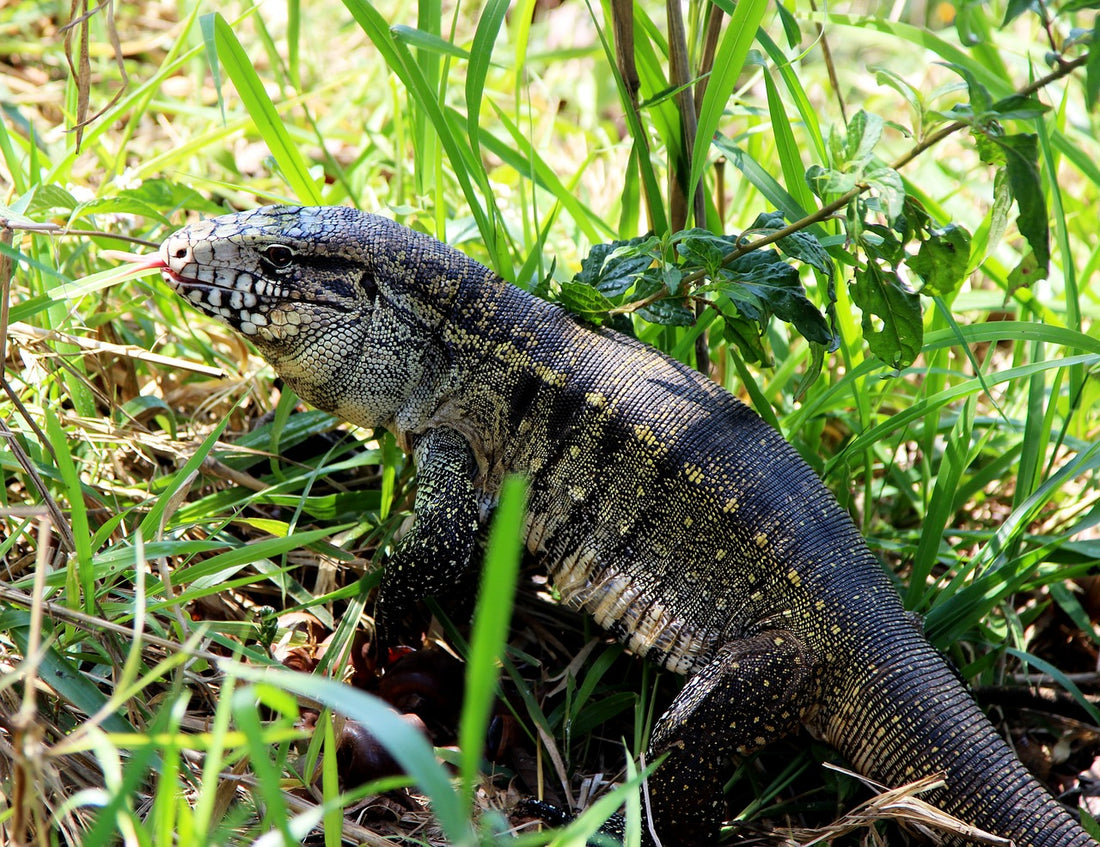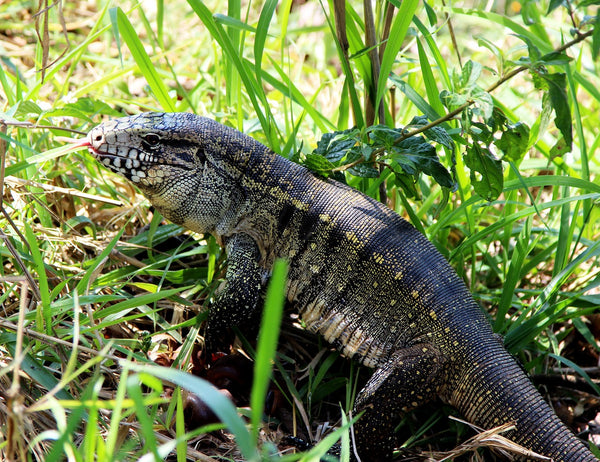
Guest Post by Mike Valverde
When you think of reptiles kept as pets, what are some of the first creatures that come to mind? Maybe you think of leopard geckos or bearded dragons since they’re among the most common lizards kept as pets. Maybe you’re picturing something a bit more exotic, like a chameleon or a ball python.
One of the reasons why herpetoculture is so fascinating to so many people is that it’s unique. Instead of adopting a traditional furry pet like a dog or cat, many of the people who choose to care for a scaly cold-blooded pet are attracted to their unconventional nature and appearance. A true reptile lover will tell you that their pets are no less adorable or affectionate than any other— and they can be surprisingly intelligent as well.
Speaking of intelligent reptiles, I bet tegus were one of the last creatures that came to your mind when picturing a pet reptile if it came to mind at all. Truthfully, these distant cousins of the monitor family aren’t as popular among most reptile owners. And that’s a real shame because tegus are some of the smartest and most interesting lizards you can keep as a pet!
So keep reading to learn more about tegus, including some helpful tips on tegu feeding and general care. Check it out:
What are Tegu lizards?
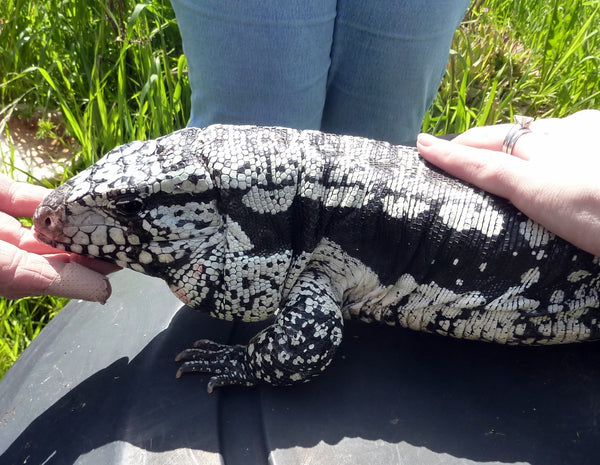
Photo taken by Jessica Merz and uploaded to Flickr.
First, a quick clarification: tegus are not monitors. If you hear anyone refer to these creatures as ‘tegu monitors,’ they are mistaken.
Although both kinds of reptiles have several similarities, tegus are from the Tupinambis genus and monitors are from the Varanus genus. To make matters even more confusing, some species of tegu were reclassified as the Salvator genus about 8 years ago. Basically, tegus and monitors are kind of different but mostly the same as a result of their convergent evolutionary paths. As a pet owner, this means you shouldn’t rely on information for taking care of monitors when taking care of tegus, and vise versa.
With that out of the way, let’s talk about what tegus actually are. If you’re interested in adopting a pet tegu, these are the most common species you’ll encounter:
- Argentine black and white tegu
- Blue tegu
- Red tegu
- Colombian gold tegu
Not sure which one is best for you? Check out our detailed breakdowns for each type of tegu below:
Argentine Black and White Tegus
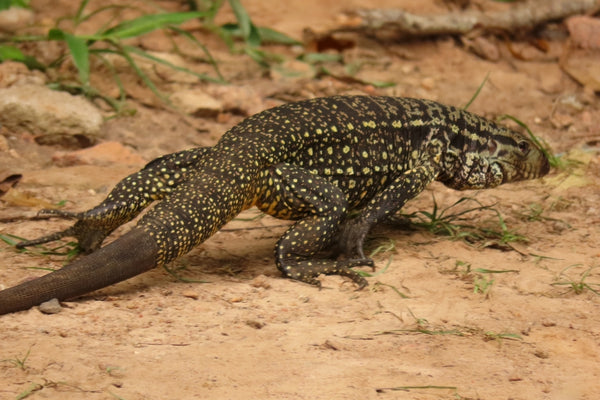
Black and white tegu in Porto Alegre, Brazil. Photo taken by José Carlos Merino Mombach and uploaded to iNaturalist.
These tegus go by many names, including Argentine tegu, Giant tegu, and black and white tegu. (You may occasionally see a breeder advertising Colombian black and white tegus, but there’s actually no such thing.)
Black and white tegus are native to Argentina, as their name implies. They’re larger than most other lizards and are best suited to warm climates with lots of water, such as savannas and rainforests. Despite being native to South America, wild Argentine tegus are often found in parts of Florida as an invasive species— a consequence of inexperienced owners releasing them into the wild.
Argentine tegu feeding
Generally speaking, tegus are omnivorous and can eat a wide variety of foods. In the wild, black and white tegus commonly eat insects, fruits, seeds, and the eggs of other animals. Since they can grow to be very large (up to five feet long), some wild Argentine tegus have even been known to eat small birds!
Argentine black and white tegu pets are usually given a diet of mostly insects when they’re very young. If you’re interested in raising these creatures from a young age, we recommend our Tegu Hatchling Bundle for its high nutritional content.
When they get older and bigger, a healthy black and white tegu diet will typically include cooked eggs and turkey meat to meet their increased need for protein. It’s also highly recommended that you feed black and white tegus tropical fruits such as papayas, mangos, and kiwis. Some black and white tegu owners will feed their pets dog food or cat food, although we recommend our Mega Blend of fruits and veggies for optimal nutrition.
Argentine tegu care
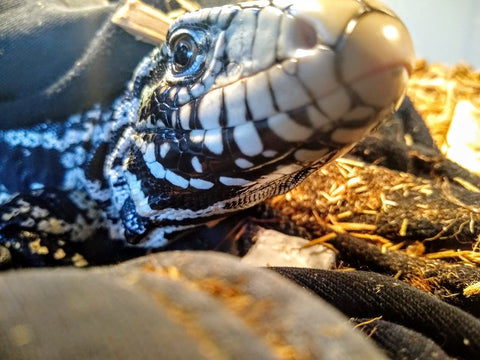
Here are some additional tips for taking care of a pet black and white tegu:
- Handle them often: Argentine tegus will get more docile as they get older, which means that they can get along really well with humans. However, you need to make sure your pet is accustomed to being handled; otherwise, they can become anxious and might lash out. And when considering the fact that these creatures can grow to have an incredibly strong bite, you don’t want to get on their bad side!
- Give them lots of space: As hatchlings, these creatures can be comfortably kept in a 40-gallon tank for a few months. However, tegu size changes are frequent and sporadic, so you’re better off moving your pet to a larger enclosure sooner rather than later. You’re going to want to give your pet a lot of space once it grows into adulthood. Most tegu keepers recommend an enclosure that’s between 6-8 feet long, 3-4 feed wide, and around 3 feet deep.
- Don’t let them loose: As I previously mentioned, Argentine tegus are an invasive species in Florida. That means they’re threatening the existence of other species in the area by eating them and their food. If you feel as though your Argentine black and white tegu’s size, eating habits, or behavior is too much for you to handle, reach out to a local pet shelter or veterinarian to find out how you can safely give up your pet for adoption.
Blue Tegus
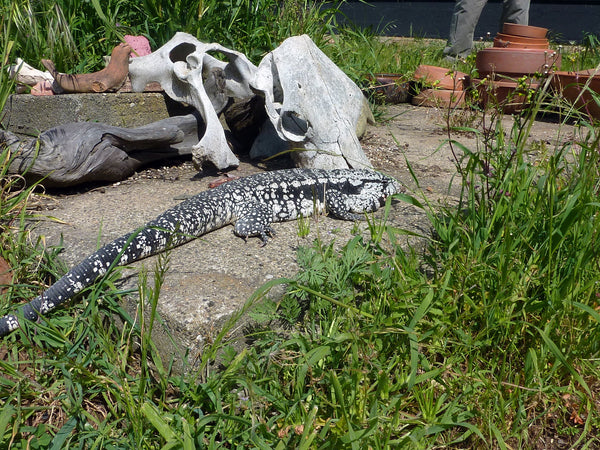
Photo taken by Jessica Merz and uploaded to Flickr.
Blue tegus are similar in many ways to black and white tegus, since they’re also members of the Salvator genus and are found in South America. In fact, they’re sometimes referred to as Argentine blue tegus for this reason. Aside from their blue color, what makes these reptiles so different from the black and white variety is their size, since they typically only grow to a maximum length of approximately three feet.
Blue argentine tegus are a very popular pet choice as far as tegus go. Their smaller average size is one reason for this, but they’re also quite docile. In fact, some blue tegu lizards can even be kept in pairs— with the proper husbandry techniques!
Blue tegu feeding
Since they’re so similar to black and white tegus, a blue tegu diet is essentially the same. Stick to nutritious protein-rich insects like Dubia roaches when they’re young, or simply feed them our Hatchling Bundle for a balanced meal.
When they get older, you’re going to want to feed them lots of lean cooked meat. However, they’re not as fond of fruit as their black and white siblings, so you’ll want to look into calcium supplements to ensure they’re getting enough. Alternatively, the ground-up rabbit bones in our Insect & Rabbit links are a fantastic source of Calcium for your blue tegu, and the addition of some quail eggs can help them absorb Vitamins A and D.
Blue tegu care
Interested in having a blue tegu pet of your own? Consider these quick tips to ensure you raise it the right way:
- Handle with care: As I previously mentioned, Argentine blue tegus are slightly smaller and more docile. This can mean that it’s easier for less experienced reptile enthusiasts to keep them as pets. With that being said, you should still be careful to avoid agitating your pet if you don’t want to get bit!
- Budget accordingly: Because blue tegus are slightly more convenient to care for, the demand for these creatures is often greater than the supply. Consequently, you can expect to pay a breeder quite a bit more than you would for some other reptiles— especially if you want a unique morph!
- Might not play well with others: Although it is possible to keep two blue tegus in the same enclosure, you need to be extremely careful that they aren’t both male. Keeping one male and one female can cause issues too, especially if you’re not interested in blue tegu breeding. For the best results, stick to two females as roommates and give them plenty of space!
Red Tegus
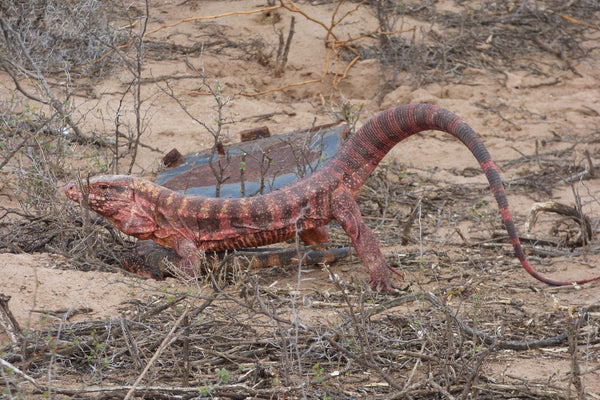
Red tegu in Belgrano, Argentina. Photo taken by oscarvm and uploaded to iNaturalist.
Just like black and white tegus and blue tegus, red tegus are members of the Salvator genus and are native to Argentina. And as you may have guessed from the name, these reptiles typically have a dull reddish tone on their scales that grows more prominent as they age.
Aside from the color, there’s not too much to distinguish these tegus from the other Argentina varieties. Many people will say that Argentine red tegus are larger than other colors on average, but this isn’t backed by any legitimate evidence. It’s unclear whether black and white tegus or red tegus are the bigger reptile; it ultimately depends on the breeder and the pet owner.
Red tegu feeding
Since they’re so similar to the other Argentina-based tegus, you can assemble a red tegu diet that’s essentially identical to those listed above. Hatchlings and yearlings love our Tegu Hatchling Bundle, but they’re also fond of Dubia roaches and silkworms.
When they get older, you’ll want to incorporate more lean meats with the insects. However, red tegus are known to be more interested in fruits (unlike blue tegus) so you’ll want to ensure they have a fresh supply. You may want to consider our Guinea Fowl + Fruits & Veggies links due to their high concentration of blueberries, raspberries, and blackberries.
Red tegu care
Keep reading for some additional tips on red tegu care that can really help you out:
- Simple housebreaking: Although just about any Argentine tegu can be housetrained, red tegus are especially well-known for this. Using a clicker and positive reinforcement training, you can teach your pet reptile to drink from a specific water dish like a dog or cat. In fact, some trainers have even taught their pets to walk outside in order to ‘answer the call of nature.’
- Outdoorsy type: If you live in a part of the world that isn’t too cold and has decent humidity, you can set up an excellent red tegu enclosure outdoors. This can be a great way to ensure your pet has enough room to bask, burrow, and eat— even if you live in a small home. Just make sure that you build a strong enough barrier to keep your Argentine tegu from escaping into the wild!
Gold Tegu

Gold tegu in Tauramena, Colombia. Photo taken by Diegophidio and uploaded to iNaturalist.
The last tegu on this list is the Colombian gold tegu, which is fairly different from the others mentioned above. For starters, these creatures come from a different part of South America— hence the name. Additionally, they belong to the Tupinambis genus, whereas Argentine black and white tegus, blue tegus, and red tegus are all members of the Salvator genus.
These particular lizards are uncommon among tegu pet owners when compared to the other varieties. The most likely reason for this is that it’s harder to domesticate Colombian tegus than Argentine tegus, so gold tegus are better suited for experienced herps.
Gold tegu feeding
A typical gold tegu diet is omnivorous and indiscriminate, much like their Argentinian relatives. This means they also enjoy a diverse diet of lean meats, insects, eggs, and occasional fruits and veggies. Our Tegu Hatchling Bundle and Mega Blend are excellent products for baby and adult Colombian gold tegus respectively. However, we also recommend adding in quail eggs or some other Calcium supplement to offset the lack of fruit in their diet.
Gold tegu care
Although not as easy as taking care of a blue tegu or a red tegu, following these tips should help you handle a gold tegu pet:
- Handle with gloves: It bears repeating that these kinds of tegus are more difficult to domesticate than any of the other species listed above. Because of that, most gold tegu breeders and owners recommend using a thick pair of oven mitts or gardening gloves when handling your pet, since they can help to cushion any bites.
- Proper lighting is essential: Although all the tegus listed here need proper lighting in their enclosures, this is especially important with gold tegus. In order to help them get the necessary amount of Vitamin D, you’ll want to use UV-B bulbs in the lighting system of your gold tegu enclosure.
Thanks for reading!
Sources
- https://www.britannica.com/animal/tegu
- https://myfwc.com/wildlifehabitats/nonnatives/reptiles/whiptails-and-wall-lizards/tegu/
- https://www.npr.org/2016/02/20/467499871/invasive-lizards-threaten-floridas-natural-species-in-the-everglades
- https://tegusfromaroundtheworld.weebly.com/food-list.html
- http://www.reptilesmagazine.com/Tegu-Lizard-Housing-And-Care-Information/
- https://web.archive.org/web/20021207223247/http://www.bluetegu.com/blue.html#
- http://www.petpeoplesplace.com/316-faq-housing-tegus.htm

